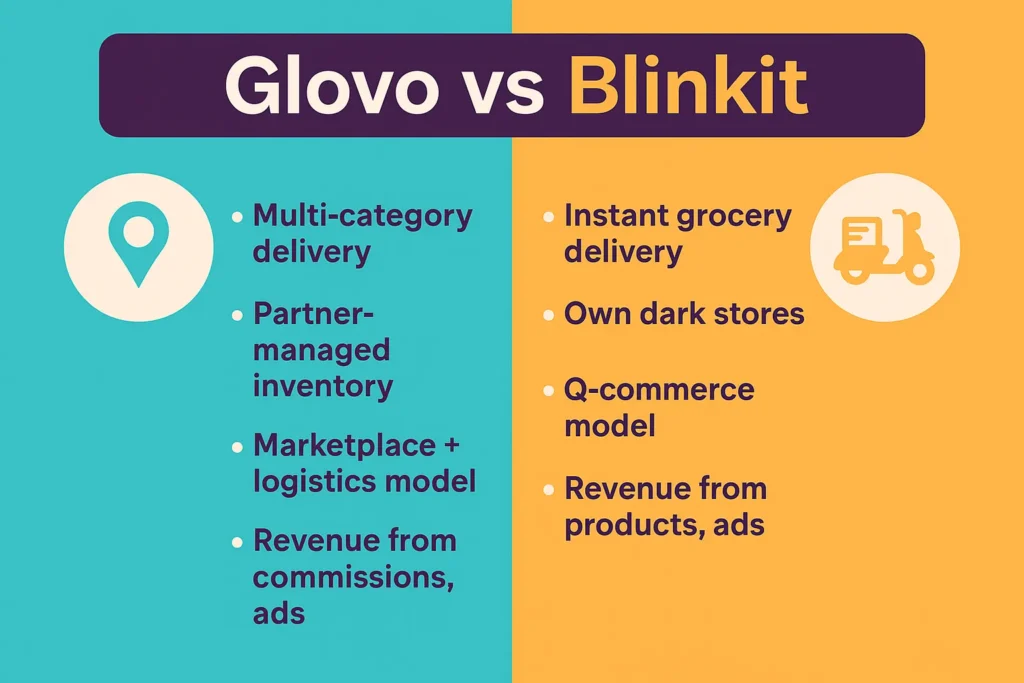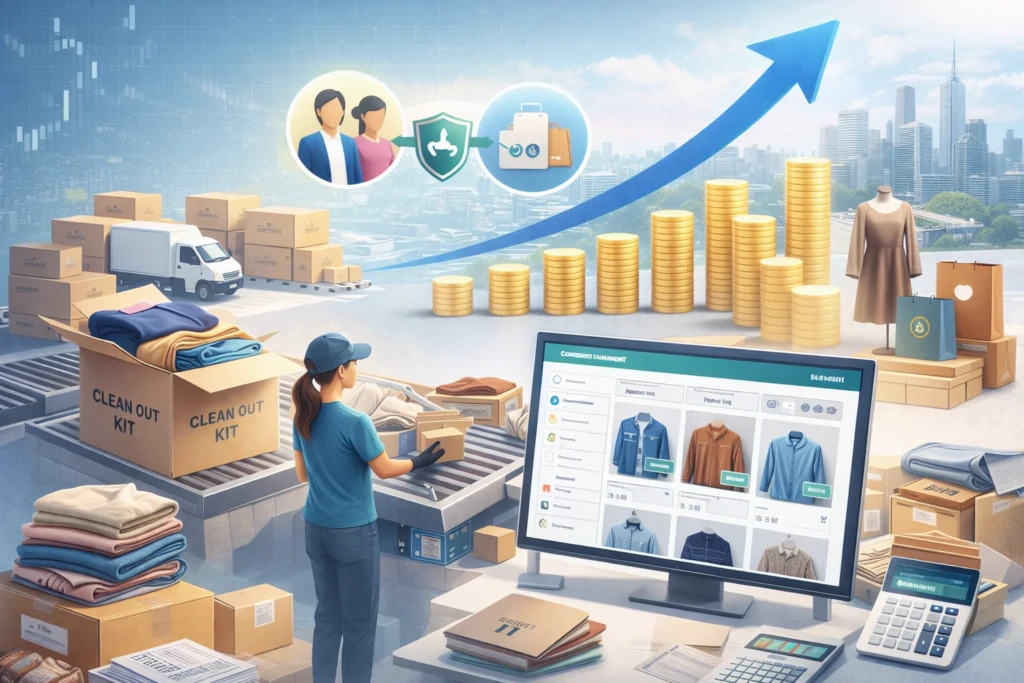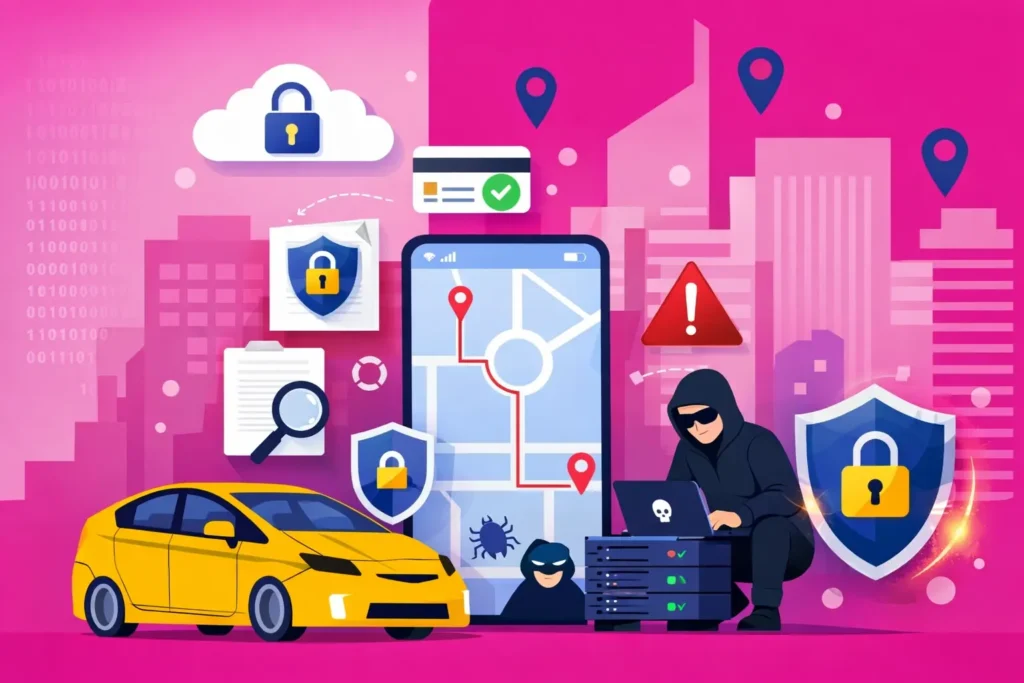In 2025, the on-demand delivery ecosystem has matured into a multi-billion dollar industry powered by speed, convenience, and tech innovation. Amid this evolution, two names dominate different geographies with strikingly different business strategies: Glovo, a European powerhouse, and Blinkit, India’s rapid-delivery disruptor.
For startup founders and app entrepreneurs, this comparison isn’t just academic—it’s strategic. Choosing the right business model for your delivery startup can shape everything from your market entry to your monetization strategy and long-term scalability. Whether you’re eyeing urban logistics, Q-commerce, or dark store operations, understanding the Glovo vs Blinkit business model landscape is essential.
This long-form, EEAT-compliant breakdown will guide you through both models, comparing their revenue channels, operations, partnerships, cost structures, and growth paths—so you can decide what’s best for your next venture.
Let’s begin with an overview of each brand.

What is Glovo?
Glovo is a Spanish on-demand courier service that allows users to purchase, pick up, and deliver items within their city. Founded in 2015 in Barcelona, Glovo operates across 25+ countries, mainly in Southern Europe, Eastern Europe, and Latin America.
Key Highlights:
- Multi-category delivery app (food, groceries, pharmacy, courier)
- Operates in a marketplace + logistics hybrid model
- Known for the “anything you want” delivery promise
- Acquired by Delivery Hero (majority stake)
Glovo stands out with its wide use case flexibility—it’s not just groceries or food; it’s literally anything deliverable within a city.
What is Blinkit?
Blinkit (formerly Grofers) is an Indian instant delivery platform focusing primarily on groceries and daily essentials. Rebranded in 2021, Blinkit popularized 10–20 minute deliveries across India’s metro cities. It was later acquired by Zomato in a strategic move to expand Q-commerce services.
Key Highlights:
- Operates on a dark store model
- Offers groceries, FMCG, electronics, and household items
- Fulfilled over 1 million+ orders/day in 2024
- Strong presence in Tier-1 Indian cities
Blinkit is a front-runner in India’s quick commerce race, relying on micro-warehouses and high-frequency orders for profitability.
Business Model of Glovo
1. Revenue Streams
- Delivery Fees: Paid by users per order.
- Commission from Partners: Restaurants, stores, and merchants pay a percentage of each sale.
- Subscription (Glovo Prime): Monthly subscription for free deliveries.
- Ad & Promotion: Sponsored listings and app placements.
- Courier Fees: Third-party deliveries through Glovo for Business.
2. Cost Structure
- Rider wages and incentives
- Partner onboarding and commissions
- Customer support and issue resolution
- Technology development (app, routing, AI/ML)
- Marketing and customer retention
3. Key Partners
- Restaurants, grocery stores, pharmacies
- Corporate clients (B2B deliveries)
- Local couriers and freelance delivery agents
- Fintech and payment service providers
4. Growth Strategy
- Market diversification across geographies
- Acquisitions of regional players
- Increasing order density per zone
- Loyalty plans like Glovo Prime to drive frequency
- AI-driven logistics optimization
Learn More: Business Model of Glovo: How It Works and Makes Money
Business Model of Blinkit
1. Revenue Streams
- Product Sales Margin: Sells products directly from dark stores.
- Delivery Charges: Nominal fees per order.
- Zomato Integration: Cross-promotion and user migration revenue.
- Private Labels: Exclusive in-house brands with higher margins.
- Ads and Promotions: Merchant and FMCG brand listings.
2. Cost Structure
- Dark store setup and operations
- Inventory procurement and warehousing
- Rider fleet salaries and optimization
- Fulfillment and last-mile logistics
- Heavy tech spend on speed and accuracy
3. Key Partners
- FMCG companies and wholesalers
- Local farmers and suppliers
- Logistics partners and last-mile fleets
- Zomato ecosystem integrations
4. Growth Strategy
- Expand dark stores to new high-density neighborhoods
- Boost unit economics through private labels
- Leverage Zomato’s customer base
- Introduce instant delivery beyond groceries (electronics, gifts)
Learn More: Business Model of Blinkit | Revenue Strategies
Comparison Table: Glovo vs Blinkit
| Feature | Glovo | Blinkit |
|---|---|---|
| Core Focus | Multi-category On-demand Delivery | Instant Grocery & Essentials Delivery |
| Operating Regions | Europe, Latin America, Middle East | India (Major metro cities) |
| Revenue Sources | Commissions, Delivery Fees, Ads | Product Margins, Delivery Fees, Ads |
| Inventory Model | Partner-managed | Owns Inventory (Dark Stores) |
| Delivery Time | 20–45 minutes | 10–20 minutes |
| Monetization Strategy | App ads, subscriptions, courier fees | Product margins, ads, Zomato synergy |
| Parent Company | Delivery Hero | Zomato |
| User Base | Global | Domestic (India-centric) |
Pros & Cons of Glovo’s Business Model
Pros:
- Versatile delivery categories
- Asset-light, low CapEx approach
- Strong international expansion potential
- Good fit for freelance and gig-based economies
Cons:
- Complex partner management at scale
- Higher last-mile variability in non-core categories
- Dependent on merchant quality and stock
Pros & Cons of Blinkit’s Business Model
Pros:
- High control over inventory and fulfillment
- Superior speed with dark store proximity
- Higher basket value via bundled offers
- Predictable user experience
Cons:
- High capital expenditure
- Inventory risks (expiry, overstock)
- Challenging scalability in low-density regions
Market Data: Growth, Revenue, and Funding
| Metric | Glovo | Blinkit |
|---|---|---|
| Annual Revenue (2024 est.) | ~$900M USD | ~$350M USD |
| Active Cities | 1,500+ globally | 25+ Indian cities |
| Monthly Active Users | 15M+ | 10M+ |
| Total Funding | $1.2B+ (pre-Delivery Hero acquisition) | ~$700M+ (pre-Zomato acquisition) |
| Parent Company | Delivery Hero | Zomato |
Which Model is Better for Startups in 2025?
It depends on your geography, funding level, and startup goals.
- If you aim to build a diverse multi-category delivery app that can scale across regions with moderate CapEx, Glovo’s partner-first model offers more flexibility and less upfront inventory risk.
- If you’re focused on ultra-fast commerce with tight control, Blinkit’s dark-store model is efficient and loyalty-driving—but requires strong logistics and funding.
Choose Glovo-Style Model If…
- You’re targeting a global or multi-regional market
- You prefer an asset-light model with third-party partnerships
- You want to offer more than just groceries
- You’re building a gig-economy friendly platform
Launch a Glovo-style App with Miracuves
Choose Blinkit-Style Model If…
- You’re targeting Tier-1 urban centers
- You can manage inventory and fulfillment directly
- You want extreme delivery speed as a USP
- You’re integrating with a food or commerce ecosystem
Build a Blinkit-style App with Miracuves
Conclusion
Both Glovo and Blinkit present scalable and proven business models that cater to different operational strengths. While Glovo excels in market versatility and gig-friendly logistics, Blinkit leads in instant fulfillment, inventory control, and user loyalty.
For startup founders, the choice boils down to vision, funding, geography, and customer behavior. And no matter which model you choose—Miracuves has the tech stack, design expertise, and growth support to help you launch a powerful delivery platform in record time.
FAQs
1. What is the main difference between Glovo and Blinkit’s business model?
Glovo operates a partner-based model with no inventory, while Blinkit uses dark stores to manage its own supply and fulfillment.
2. How does Blinkit’s need for warehousing and inventory affect its scalability compared to asset-light models?
Blinkit’s model requires more upfront investment due to warehousing and inventory management.
3. Can I build a Glovo-like app in Asia or MENA?
Yes. Glovo’s marketplace-style model is highly adaptable to international markets, including Asia and MENA.
4. Which model scales faster?
Glovo’s asset-light model can scale quickly across geographies, but Blinkit scales deeper within cities via infrastructure.
5. Does Miracuves offer white-label solutions for both models?
Absolutely! Miracuves builds custom Glovo and Blinkit clones with full branding, features, and performance optimization.








